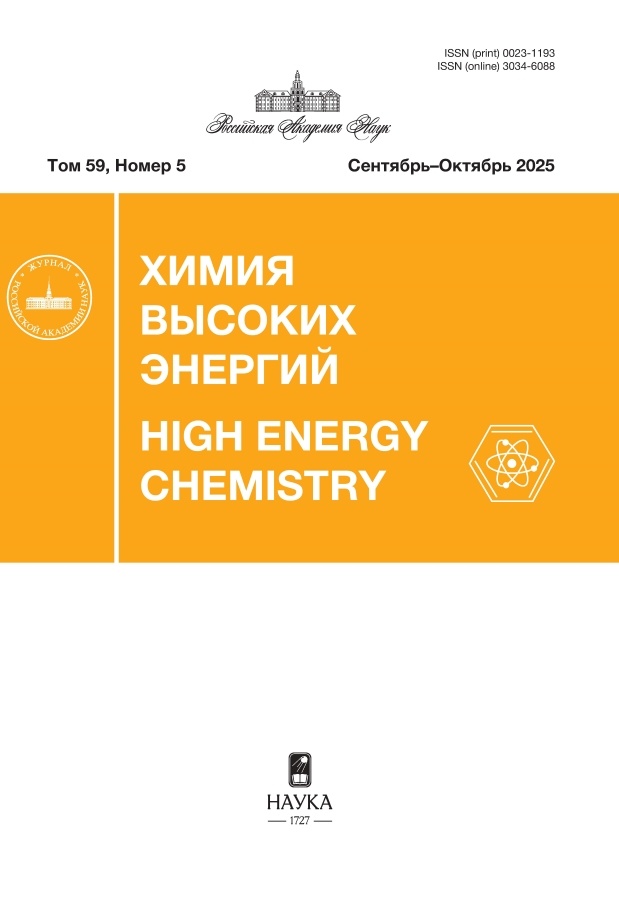Himiâ vysokih ènergij
ISSN(Print): 0023-1193
Media registration certificate: No. 0110274 dated 02/08/1993
Founder: Russian Academy of Sciences, Institute of Physical Chemistry RAS
Editor-in-Chief: Razumov Vladimir Fedorovich
Number of issues per year: 6
Indexation: RISC, list of Higher Attestation Commissions, CrossRef, White List (level 3)
Current Issue
Vol 59, No 5 (2025)
GENERAL QUESTIONS
Mechanism of fulvic acid decay under the influence of microwave radiation: results of quantum chemical calculations
Abstract
 303-308
303-308


PHOTONICS
Effect of synthesis conditions on phase composition, structure and lifetime of photogenerated current carriers in quadruple copper compounds cu2-Δ srsns4(0≤δ<0.4)
Abstract
By the method of solid-phase ampoule synthesis the samples of Cu2-δSrSnS4 in the range of 0 0.4 were obtained. Cu2-δ SrSnS4in the range of 0≤δ<0.4, their lattice parameters were specified, and Raman spectra were studied as a function of δ. It was found that for these compounds a narrower region of single phase is observed in comparison with the compounds Cu2-δ BaSnS4 having similar structure. At the same time, Cu2-δ SrSnS4 samples are unstable when annealed in vacuum. By the method of microwave photoconductivity it was found that additional annealing of Cu2-δ SrSnS4 in the presence of SnS2 leads to a marked increase in the lifetime of photogenerated current carriers, which is apparently due to a decrease in the number of impurity phases and structural defects formed due to thermal instability during synthesis.
 309-316
309-316


ФОТОХИМИЯ
Oxidation of unsymmetrical dimethylhydrazine by triplet nitro compounds
Abstract
The transfer of one of the oxygen atoms of nitro compound molecules in the T1 state to one of the nitrogen atoms of unsymmetrical dimethylhydrazine molecule in the S0 state has been studied using the B3LYP/6-311G+(d) quantum chemical method. This process is one of the possible routes for photochemical oxidation of nitrogen-containing compounds by nitro compounds. Two possible reaction variants with attack on the N-dimethyl nitrogen atom (1) and the nitrogen atom of the hydrazine group (2) have been considered. Quantum chemical calculations show that such reactions are possible due to relatively low Gibbs energy. The corresponding values lie in the range of 99–111 kJ/mol for reaction (1) and 136–123 kJ/mol for reaction (2). Calculations of spin densities on atoms in the transition state show that there is no significant change in the distribution of spin density on the atoms of the reaction center. The obtained data may indicate a biradical character of the process. It has been concluded that the oxygen transfer reaction to the nitrogen atom with dimethyl substituents is energetically more favorable.
 317-321
317-321


RADIATION CHEMISTRY
On the Effect of Ionizing Radiation on a Fluorescent Dye in Solution, in Complex with DNA and in Its Cholesteric Liquid-Crystalline Dispersion
Abstract
 322-335
322-335


Effect of gamma-irradiation of papain on physicochemical properties of its aqueous solutions
Abstract
 336-343
336-343


Degradation of albumin and aromatic amino acids in reactions with radicals OH● and under the influence of UV radiation 253.7 nm
Abstract
 344-350
344-350


PLASMA CHEMISTRY
Influence of non-thermal plasma of atmospheric pressure glow discharge on surface modification of maize seeds
Abstract
 351-355
351-355


Modification of surface properties of plastic filaments in a plasma three-electrode tube
Abstract
The modification of surface properties of thermoplastic polymers, in particular, plastic filaments of Polylactic Acid (PLA), by their treatment in a plasma three-electrode tube with low-temperature argon plasma of a volumetric independent glow discharge with a dielectric barrier at atmospheric pressure has been experimentally demonstrated. A PLA plastic filament is continuously pulled at a velocity of 4 mm/s through the discharge plasma at a discharge current of 0.7–3 mA. The water contact wetting angle is shown to decrease from 8° to 44°, the free surface energy is shown to increase from 32.28 to 56.84 mJ/m2.
 356-359
356-359


Torrefaction of Granulated Peat Using Atmospheric Pressure High-Frequency Plasma Discharge
Abstract
 360-366
360-366


The Effect of Underwater Diaphragmatic Discharge (UDD) on Particle Sizes in Aqueous Colloidal Copper Solution
Abstract
 367-372
367-372












